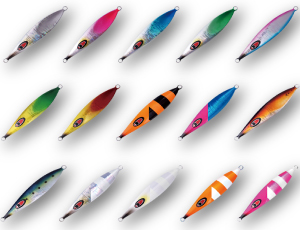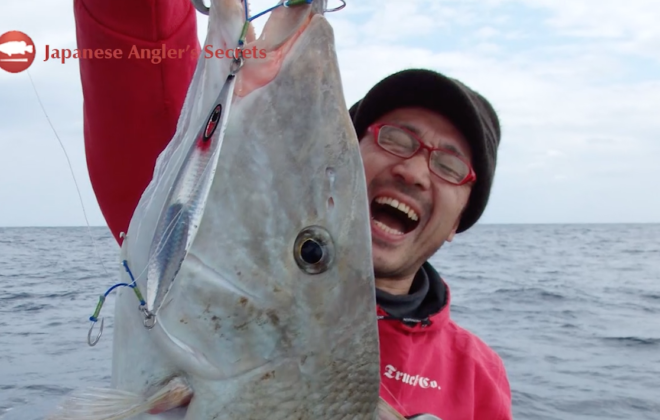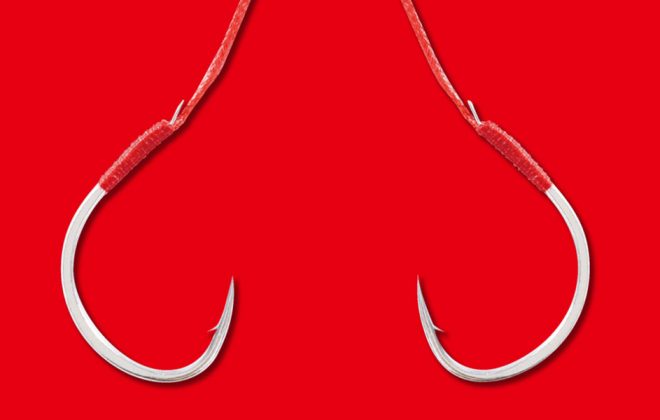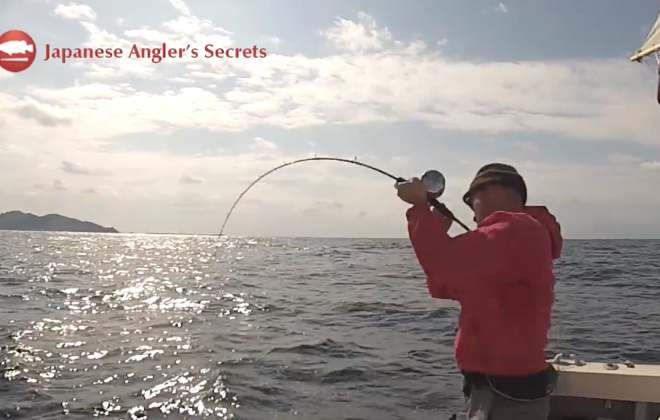What color of the jig works better?
Does fish recognize colors?
I guess this is an agenda that has never been clearly answered.
Study shows some fish recognizes colors and some don’t. Fish which habit in a shallow clear water recognize more colors. Fish in the open water or in the deep water can see shapes (contrast) rather than colors.
It is also believed that fish develop red skin because red is the most invisible color in the water as the water absorbs red light first.
The color is so limited in the deep. Even if the fish senses the light, is the color important at all? Do they care? Does fish sense the colors we humans don’t see? Why does some organism in the deep ocean have such colorful body?
Some things we just don’t know.
Most jiggers believe that the color of the jig is not as important as the glow, and that they are far less important than the size and the movement of the jig.
Sato Sensei says little about colors too. He only says the glow has advantages in deep water. He also points out the predatory fish should be accustomed to zebra pattern because a lot of young fish has this pattern on the body.
My fellow anglers and I think that the glow may matter but the colors don’t.
We usually fish from 100m to 200m of water.
But the jig makers produce so many colors and patterns and you have to choose when you buy them. We choose silver, red, and pearl ones with glow patterns, because we think that’s probably what our targets are familiar with. But not that it’s so important.
There are also a lot of glow patterns as well. Zebra glow is definitely the standard pattern. All grow (plain flat glow) is very appealing profile. Ghost zebra glow (faint glow) is low profile.
Neither of them are good or bad. We just need to make different calls until we get contacts, believe that it is what the fish likes, either the actions, the speed, the size, or the color, and change something when we don’t get contacts. The color is a tiny factor of all the unlimited combinations, or not.
It just depends on what you believe.
Having varieties of colors is very important for the sales of jig making business and retail shops. Those experts would never say the colors don’t matter.
I personally believe that the eyesight is very auxiliary in the fish sensory system. We humans depend 80% on sights. We can’t project that to underwater creatures.
Fish has auditory sensor all along their body. They are all ears, so to speak. Hearing should be their primary sensor. Water is such a medium that delivers sound waves so well, 4 times faster than the air, and a lot further in distance too. Some say the sound travels 1000km and further if given a good condition. It’s also known that the layers of water of different temperature or quality set up walls to bounce back the sound waves, which is why it’s important, when you fish, to target the depth where your fish is.
Have a look at dolphins. They used to be land mammals and have evolved to adopt to underwater life. They still have good eyesights. But their primary sense is hearing. They have developed the famous echolocation, active auditory sensory system. I tell you, the water is the world of sounds. Fish should hear their prey swimming and making turbulence.
Fish is said to be keen to smells too. Fish should smell or taste the current. Maybe that’s how they locate the school of fish. But the smell is slow to spread, and I don’t think it’s an appropriate sense for targeting individual prey.
My conclusion is that, at 50m or deeper water, fish locates, targets, and chases its prey mainly by sounds. Sounds are vibrations. Movements make vibrations.
Fish also uses a help of vision too. Only secondary. Especially for the last moment of the chase and the bite. The visual of the jig only needs to be something natural or familiar to them. Catching the prey is probably the main purpose. It is not examining and judging by the color and pattern of the target. I highly doubt that how the jig is painted matters at all.
What do you think?
Tags In
Related Posts
6 Comments
Leave a Reply Cancel reply
Categories
- 1. SPJ (57)
- 1-1. Principles (9)
- 1-2. Techniques (11)
- 1-3. Setup (17)
- 1-4. FAQ (19)
- 1-5. Tackles (3)
- 1-6. Video Gallery (2)
- 2. Other Offshore Games (5)
- 3. Fishing Report (105)
- 3-1. Totos (25)
- 3-2. Readers (72)
- 4. Fish Cooking (19)
- 4-1. Iki-Jime (3)
- 4-2. The Art of Sashimi (5)
- 4-3. Recipe (7)
- 4-4. Seasoning (3)
- 5. Fishing Charter (6)
- Fish (12)







Hi Totos,
Nice write up as usual, there was an interesting article in Saltwatersportman online written by George Poveromo titled “Can fish see colors?”. I still keep the captured text of his article in my computer, so I would like to quote part of it here, as follow:
“The Science of Vision
“A big factor is the color spectrum and what happens when light moves into the ocean,” says Dr. Linda Farmer, director of the Undergraduate Program in Marine and Atmospheric Science for the University of Miami. “As light travels through the water, red, which is the longest wavelength, is absorbed first, followed by orange, yellow, green and blue and, eventually, indigo and violet [the shortest wavelength], leaving no sunlight below a certain depth. Red will appear as a faint black. The color violet will remain intact the longest.” It should be noted that how far down these colors penetrate varies based on water clarity, the amount of light and other factors.
The complexity of vision in fish varies from species to species. Some experts believe that offshore fish such as billfish, tuna, wahoo and dolphin are colorblind and only distinguish objects that contrast with the background they see. These fish are thought to possess two visual pigments, sensitive to blue and yellow light. According to Farmer, some inshore fish have more than two pigments. Fish with four pigments can detect many colors and can distinguish bright and dark objects against any background.”
I personally believe shade/pattern (of color)of the lures is more significant than the color itself. And I agree with you that hearing is the important part that activates the fish predator instinct.
Regards,
Kitidas P.
Thank you Kitidas for sharing the great additional information.
Yes, this is exactly the information I have in the background. This indicates that in the deep water the color is just the indication how visible the object is huh?
On the other hand, there are a lot of self luminescence organisms in the ocean so I think the glow does make sense.
But anyway, we agree that the predatory fish is more keen to their hearing when they hunt.
Hello Totos,
Cephalopods such as squid and cuttlefish use bioluminesce to produce startling displays including a glowing, banded pattern that ripples the lenght of the mantle. This display resembles a glowing zebra jig and could explain why zebra has proven successful.
Youngie.
Thank you very much Youngie for your comment. Great insight.
Squids should be everybody’s favorite huh? The zebra pattern is somewhat very common in the natural world I think.
Since my belief is the same, that is that fish can not see colors (certainly not below a specific depth), but can distinguish between patterns or self-glow items, perhaps the jigs containing phosphorus can have an advantage?
Perhaps zebra patterns with alternate phosphorus coating or just phosphorus eyes could be the ultimate jig?
Hi Ari. Thank you for your comments.
A few jigs have phosphorus painting even though it’s not so popular. I don’t have any reference if it works.
I’ve gone fishing with some leading jiggers and they always catch more than others. Especially in the tough day when others don’t catch much. And they use no special jigs as far as the colors and the patterns are concerned, even though they are tactical and selective with the size and the type, along with the tackle setting and the application. They are making the difference not with the colors.
I still believe colors are just secondary and there’s no ultimate jig that works all the time. Fish preference changes in the seasons, the time of the day, the current, and the location.